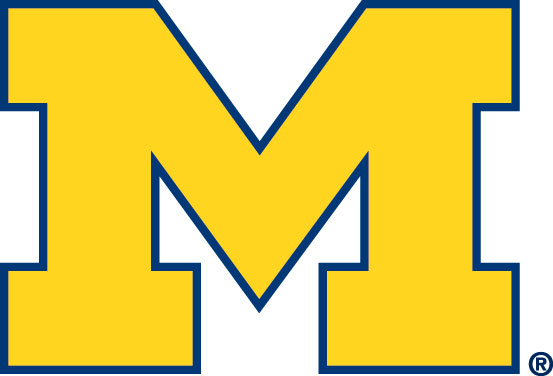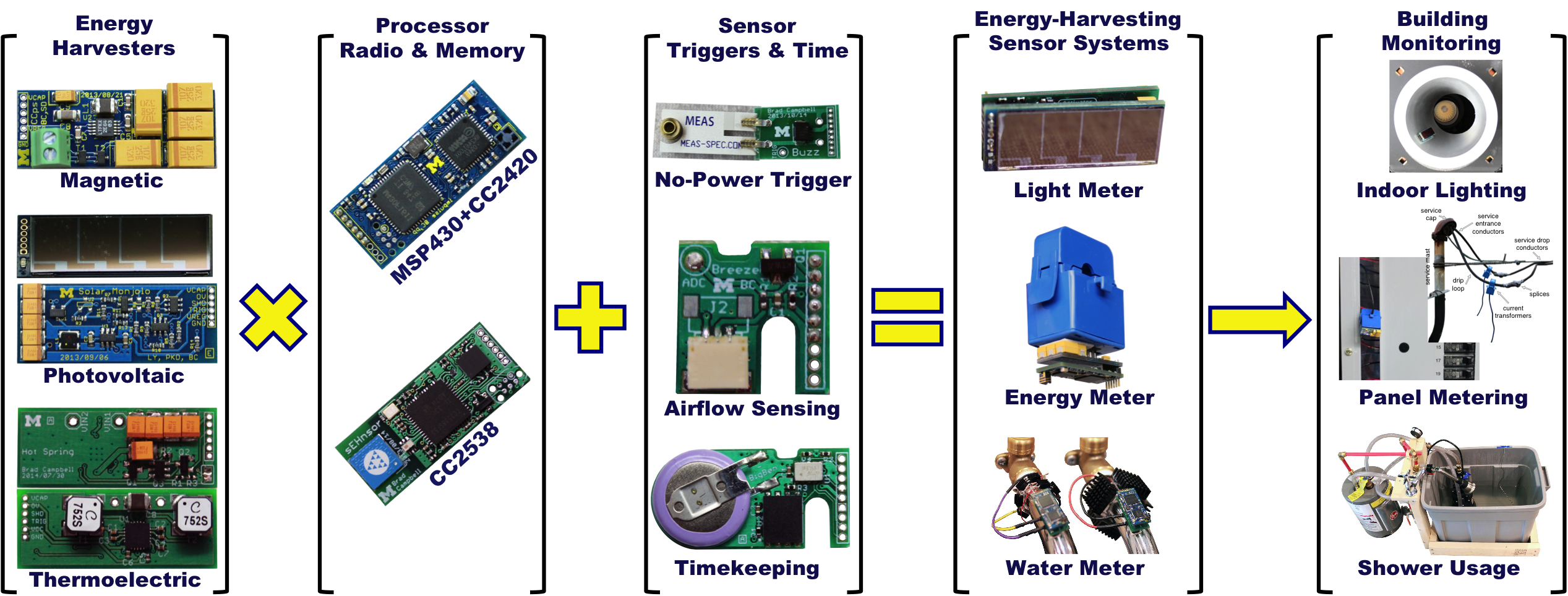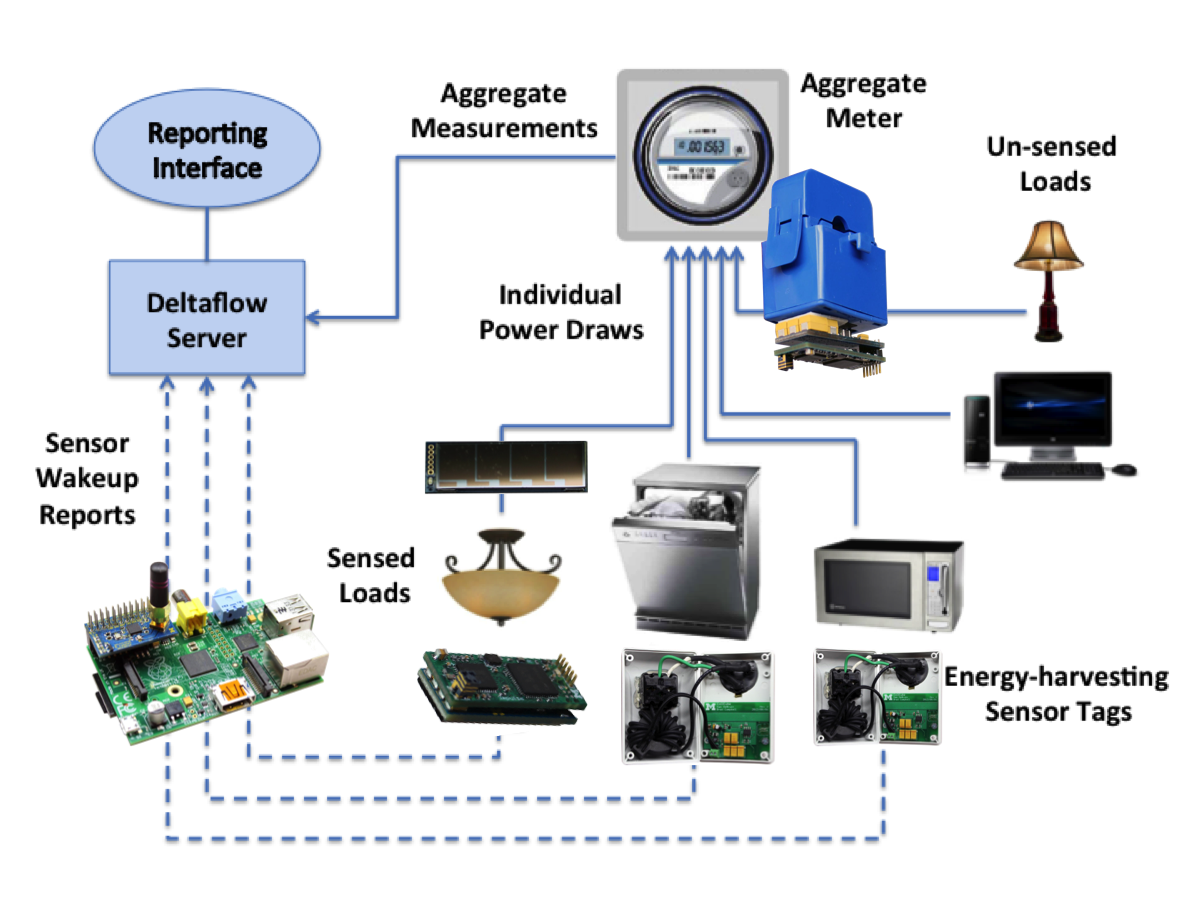
|
|
Enabling Smarter and More Efficient Buildings
Scalable Sensor Infrastructure for Sustainably Managing the Built Environment
Duration: February 1, 2014 → January 31, 2019
|
|
|
|
|
Synopsis
|
U.S. economic growth, energy security, and environmental
stewardship depend on a sustainable energy policy that
promotes conservation, efficiency, and electrification
across all major sectors. Buildings are the largest sector
and therefore an attractive target of these efforts: current
Federal sustainability goals mandate that 50% of
U.S.commercial buildings become net-zero energy by 2050. A
range of options exists to achieve this goal, but financial
concerns require a data-driven, empirically-validated
approach. However, critical gaps exist in the energy and
water measurement technology, and indoor climate control
science, needed to benchmark competing options, prioritize
efficiency investments, and ensure occupant comfort.
To address these challenges, this project proposes a new
kind of "peel-and-stick" sensor that can be affixed to
everyday objects to infer their contributions to
whole-building resource consumption. To use the sensors,
occupants or building managers simply tag end loads like a
ceiling light, shower head, or range top. The sensors
monitor the ambient conditions around a load and, using
statistical methods, correlate those conditions with
readings from existing electricity, gas, or water meters,
providing individual estimates without intrusive
metering. The sensors are built from integrated circuit
technology laminated into smart labels, so they are small,
inexpensive, and easy-to-deploy. The sensors are powered by
the same ambient signals they sense, eliminating the need
for periodic battery replacement or wall
power. Collectively, these properties address cost and
coverage challenges, and enable scalable deployment and
widespread adoption. Coupled with intelligent lighting,
heating, ventilation, and air conditioning, these enabling
technologies will lead to smarter, more efficient, and more
responsive environments.
The intellectual merit of this project stems from the
key insight that the transfer and use of energy (and other
resources) usually emits energy, often in a different
domain, and that this emitted energy is often enough to
intermittently power simple, energy-harvesting sensors whose
duty cycle is proportional to the energy being transferred
or used. Hence, the mere activation rate of the sensors
signals the underlying energy use. The power-proportional
relationship between usage activity and side channel
harvesting, when coupled with state-of-the art,
millimeter-scale, nano-power chips and whole-house or
panel-level meters, enables small and inexpensive sensor
tags that are pervasively distributed with unbounded
lifetimes. But, networking and tasking them, and making
sense of their data, requires a fundamental rethinking of
low-power communications, control, and data fusion to
abstract the intermittent, unreliable, and noisy sensor
infrastructure into actionable information.
This project's broader impacts stem from an
integrated program of education, research, and outreach that
(i) creates a smart objects focused curriculum whose
classroom projects are motivated by research needs, (ii)
provides research experiences for undergraduates and
underrepresented minorities, (iii) mentors students on all
aspects of successful research from articulating hypotheses
to peer-reviewing papers, (iv) disseminates teaching
materials on embedded systems and research pedagogy, (v)
produces students who bridge disciplines, operating at the
intersection of measurement science, information technology,
and sustainability policy, (vi) translates scientific
discovery and technical knowledge into beneficial commercial
products through industry outreach and internships, and
(vii) engages with the National Labs to ensure that the
research addresses pressing problems.
|
|
Gallery
|

Elements of the Modular Monjolo Measurement System.

Disaggregating Power with Monjolo and Deltaflow.
|
|
Demos
|
Some real-time data streams collected using the Monjolo sensors:
|
|
People
|
Members of the core project team from Michigan's
Lab 11 include:
|
|
Collaborators
|
We're working with the following third parties on this work:
|
|
Education
|
The key educational activity supported by the project is the
introduction of this research into the EECS 373 course
"Design of Microprocessor-Based Systems" at the
University of Michigan. This has enabled multiple student
teams to design hardware and software that explore the key
ideas underlying this proposal, including embedded systems,
energy harvesting, low-power sensing, and data processing.
Some students engage in undergraduate research experiences
after the class project to continue researching and
developing their class projects, characterizing the
project's performance, publishing the results, presenting
academic papers at research conferences, and (often)
continuing to graduate school (sometime with competitve
fellowships including NSF and NDSEG).
|
|
Artifacts
|
Our HW/SW designs are available from the
Lab 11
website and from GitHub.
- CoilCube: A Monjolo magnetic energy harvester layer.
- Gecko: A Monjolo solar energy harvester layer.
- HotSpring: A Monjolo thermoelectric energy harvester layer.
- Impulse: A Monjolo MSP430/802.15.4-based MCU/radio/memory layer.
- sEHnsor: A Monjolo ARM-CM3/802.15.4-based MCU/radio/memory layer.
- Blast: A Monjolo nRF51822/BLE-based MCU/radio/memory layer.
- BigBen: Time-keeping and FeRAM NV storage for Impulse board stack.
- Breeze: An indoor airflow sensor.
- Bump: A vibration motion trigger for Monnjolo.
- Buzz: A piezo-electric motion trigger for Monnjolo.
- CoilCube: An integrated Monjolo power meter.
Source code for artifacts produced under this project
include:
- Monjolo: A modular, energy-harvesting, energy metering platform.
- Harmonia: A system for localizing tiny tags indoors.
- Luxapose: A system for localizing phones indoors.
- Opo: A system for localizing people and tracking interactions indoors.
|
|
Presentations
|
Past (and planned future) non-conference presentations
related to this project:
- Prabal Dutta, "Realizing the Vision of Perpetual Smart
Dust," CMOS Emerging Technologies Research, Vancouver, BC, Canada,
May 20-22, 2015. Upcoming.
- Prabal Dutta, "Scalable Sensor Infrastructure for Sustainably
Managing the Built Environment," Distinguished Lecture Series in
Computer Science, University of Virginia, Charlottesville, VA,
Dec. 11, 2014.
Upcoming.
- Prabal Dutta, "Keynote Address," ENSsys’14: The 2nd International
Workshop on Energy Neutral Sensing Systems, Memphis, TN, Nov. 6, 2014.
- Prabal Dutta, "Monitoring Electricity and the Environment with
Mobile Phones," UC Berkeley/World Bank CEGA-DIME Workshop on
Measuring Development: Energy & Environment, Berkeley, CA, Aug. 18,
2014.
- Pat Pannuto, "Embedded System Design and the Internet of
Things," Secure Internet of Things Project's 2014 Industrial
Workshop, Stanford, CA, Aug. 11, 2014.
- Prabal Dutta, "Realizing the Next Computing Class: From
Pervasive to Perpetual Computing," Ultra-Low Power Computing
Workshop, Microsoft Research, Redmond, WA, Jul. 16, 2014.
- Prabal Dutta, "Smart Dust Sensor Networks," PLM14101:
Global Information Technology Outlook, World Economic Forum’s
Forum Academy, Jun. 17 – Jul. 29, 2014. (approximately 60
participants).
- Meghan Clark,
"Deltaflow:
Submetering by Synthesizing Uncalibrated Pulse Sensor Streams,"
University of Michigan CSE Prelim Exam, May 2014.
- Prabal Dutta, "Realizing the Next Computing Class,"
Workshop on Connected, Autonomously Powered Systems at Columbia
University, New York, NY, Apr. 11, 2014.
- Prabal Dutta, "Towards Smarter and More Efficient
Buildings," Texas Instruments, Dallas, TX, Mar. 21, 2014.
- Prabal Dutta and Anthony Rowe, "Localization Services and
Semantic Localization," Intel Corporation, Portland, OR, Mar. 14,
2014.
- Pat Pannuto, "Sensing Technologies for Data Collection and
Monitoring", The 1st Annual State of the Science Conference,
Jointly hosted by DIL, gui2de, CEGA, and USAID, Washington D.C., Mar.
7, 2014.
|
|
Publications
|
This project has supported the following publications:
⟨⟨ 2014 ⟩⟩
- "Gemini: A
Non-Invasive, Energy-Harvesting True Power Meter,"
Bradford Campbell and Prabal Dutta,
In Proceedings of the
35th IEEE Real-Time Systems Symposium (RTSS'14),
Rome, Italy,
Dec. 2-5, 2014. To appear.
- "Energy-Harvesting
Thermoelectric Sensing for Unobtrusive Water and Appliance
Metering,"
Bradford Campbell, Branden Ghena, and Prabal
Dutta,
In Proceedings of the 2nd International Workshop on
Energy Neutral Sensing Systems (ENSsys'14),
Memphis, TN,
Nov. 6, 2014. To appear.
- "An
Energy-Harvesting Sensor Architecture and Toolkit for Building
Monitoring,"
Bradford Campbell and Prabal
Dutta,
In Proceedings of the 1st ACM International
Conference on Embedded Systems For Energy-Efficient Buildings
(BuildSys'14),
Memphis, TN, Nov. 5-6,
2014. To appear.
- "Opo: A Wearable
Sensor for Capturing High-Fidelity Face-to-Face
Interactions,"
William Huang, Ye-Sheng Kuo, Pat Pannuto,
and Prabal Dutta,
In Proceedings of the 12th ACM
Conference on Embedded Networked Sensor Systems
(Sensys'14),
Memphis, TN, Nov. 3-6, 2014.
- "MBus: A 17.5
pJ/bit/chip Portable Interconnect Bus for Millimeter-Scale Sensor
Systems with 8 nW Standby Power,"
Ye-sheng Kuo, Pat
Pannuto, Gyouho Kim, Zhiyoong Foo, Inhee Lee, Ben Kempke, Prabal
Dutta, David Blaauw, and Yoonmyung Lee,
In IEEE Custom
Integrated Circuits Conference (CICC'14),
San Jose, CA,
Sep. 14-17, 2014.
- "Harmonia: Wideband
Spreading for Accurate Indoor RF Localization,"
Benjamin Kempke, Pat Pannuto, and Prabal Dutta,
In The 1st
ACM Workshop on Hot Topics in Wireless
(HotWireless'14),
Maui, HI, Sep. 11,
2014.
- "Luxapose: Indoor
Positioning with Mobile Phones and Visible Light,"
Ye-Sheng Kuo, Pat Pannuto, Ko-Jen Hsiao, and Prabal
Dutta,
In Proceedings of the 20th Annual International
Conference on Mobile Computing and Networking (MobiCom'14),
Maui, HI, Sep. 7-11, 2014.
- "System Architecture
Directions for a Software-Defined Lighting Infrastructure,"
Ye-Sheng Kuo, Pat Pannuto, and Prabal Dutta,
In The 1st
ACM Workshop on Visible Light Communication Systems
(VLCS'14),
Maui, HI, Sep. 7, 2014.
- "Deltaflow:
Submetering by Synthesizing Uncalibrated Pulse Sensor
Streams,"
Meghan Clark, Bradford Campbell, and Prabal
Dutta,
In Proceedings of the 5th ACM International Conference
of Future Energy Systems (e-Energy'14),
Cambridge, UK,
Jun. 11-13, 2014.
|
|
Prior Related Work
|
Our closely-related prior work in this areas includes:
- "Monjolo: An
Energy-Harvesting Energy Meter Architecture,"
Samuel
DeBruin, Bradford Campbell, Prabal Dutta,
In Proceedings of
the 11th ACM Conference on Embedded Networked Sensor Systems
(Sensys'13),
Rome, Italy, Nov. 11-14, 2013.
- "Grafting
Energy-Harvesting Leaves onto the Sensornet Tree,"
Lohit
Yerva, Bradford Campbell, Apoorva Bansal, Thomas Schmid, and Prabal
Dutta,
In Proceedings of the 11th International Conference on
Information Processing in Sensor Networks (IPSN'12),
Beijing,
China, Apr. 16-20, 2012.
- "Exploring Powerline
Networking for the Smart Building,"
Pat Pannuto and Prabal
Dutta,
In Extending the Internet to Low power and Lossy Networks
(IP+SN'11),
Chicago, IL, United States, Apr. 11, 2011.
- "Meter Any Wire,
Anywhere by Virtualizing the Voltage Channel,"
Thomas
Schmid, David Culler, and Prabal Dutta,
In 2nd ACM Workshop On
Embedded Sensing Systems For Energy-Efficiency In Buildings
(Buildsys'10),
Zurich, Switzerland, Nov. 2, 2010.
- "Disentangling
Wireless Sensing from Mesh Networking,"
Thomas Schmid, Roy
Shea, Mani Srivastava, and Prabal Dutta,
In Workshop on Hot
Topics in Embedded Networked Sensors
(HotEmNets'10),
Killarney, Ireland, Jun. 28-29, 2010.
Best Paper Award.
|
|
Support
|
 |
This material is based upon work supported by the
National Science Foundation under
award #1350967
(CNS-CPS). Any opinions, findings, and conclusions
or recommendations expressed in this material are
those of the author(s) and do not necessarily
reflect the views of the National Science
Foundation.
|
|
|
|

|
CSE Division
EECS Department
University of Michigan
2260 Hayward Street
Ann Arbor,
Michigan
48109
|




